
|   |

|   |
 e-mail: sunilkothari1933@gmail.com Dazzling 'Ahuti' by Nrityagram ensemble and Chitrasena Dance Company Photos courtesy: Nrityagram / Karthik Venkatraman October 4, 2019 It was a privilege to witness for three days the rehearsals of Nrityagram ensemble and Chitrasena Dance Company of Sri Lanka at the Amphitheatre of Nrityagram, before the final presentation. Choreographer Surupa Sen and counterpart Heshma Wignaraja from Sri Lanka, with team of musicians gave final touches to choreography, with dancers relentlessly correcting themselves and dancing till they dropped. One got soaked into the melodious music floating in the air. It was interesting to see the overall attention that Surupa paid to the creation of this unusual piece of dance, be it music, dance, playing of drum, entry and exit. 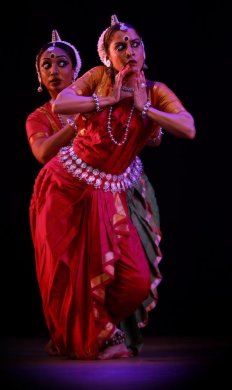 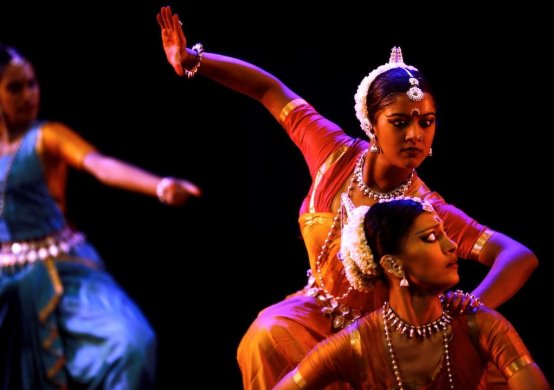 Sankirtanam ‘Ahuti’ meaning ‘offering’ is one more collaborative work of Nrityagram with Sri Lankan dancers. This time there is addition of two brilliant male dancers well versed in Kandyan dancing, Kushan Milind and Akila Palipana, along with the two female dancers Thaji Dias and Sandani Sulochani with drummer Waruna Sri Hemachandra, a disciple of Udaya Priyakumar, and the result was extremely rich and delectable. The program was divided into two sections. The first one included the signature work of Surupa Sen ‘Sankirtanam’, ashtapadi ‘Dheera sameere Yamuna teere’ solo by Surupa and ‘Purna Aarati’ with Sri Lankan artistes. Each time I see ‘Sankirtanam’ and listen to its haunting tunes and rich text, I am transported with the dancers to land of bhakti and I hum along with them ‘Nath Hare Jagannath Hare, Dehi padam’, merging with wandering minstrels who sing ecstatically describing the adbhuta - astounding beauty of the Lord; ‘Shankha gadadhara’ wielding the conch and a mace, ‘Nilakalevara’ with body shining blue, ‘Pankajalochan’, eyes with lotus shape, and one who subdued Kaliya, devotees watching with fear, but the Lord subjugates him even when he raises his fearsome hood, and there is the melodious flute, the graceful stance ‘Bankim sundar’ - Lord give us blessings. The dancers playing various instruments, dancing, welcoming the lord, performing his various deeds, succeed in creating the visuals of wandering minstrels. Urmi, Dhruva, Prithvi, Pavithra and Surupa looking at him, dance joyously and disappear, leaving an indelible impression. They set the tone for the evening. 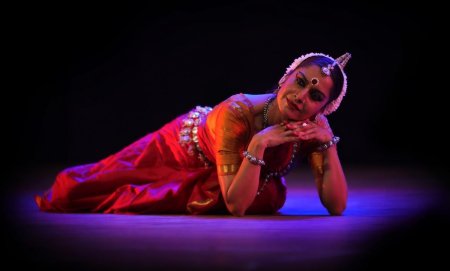 Surupa Sen Surupa’s solo as Sakhi having received message from Krishna to ask Radha to unite with him in the bower where he has prepared a bed of flowers, is a ‘tour de force’, charming, with all persuasive powers, describing the cool breeze blowing on banks of the Yamuna, where none else but one who wears a garland of forest flowers is ‘Vanamali’, the epithet the poet Jayadeva uses for Krishna. Surupa as Sakhi describes Krishna’s looking for Radha in all directions; even a falling of a leaf makes him search for Radha’s arrival. Having internalized the ashtapadi, Surupa loses herself in the role of Sakhi, describing Krishna’s dance, with ukutas, mnemonic syllables, in rhythm, holding the flute sending the message to Radha. ‘Nama sametam krita sanketam’, ‘Vadayate mriduvenu’, the poet’s words take shape, merging with swaras, Surupa’s body bending in various curves, with refrain of ‘Dheera sameere’ evoking the touch of cool breeze. Surupa dances with abandon when she tells Radha to quicken up, leave her ankle bells, and put on ‘nilanicholam’, dark colour saree, and runs round holding Radha’s arm. Her mission is fulfilled and she gently leaves the bower, and Krishna as it were, through flute thanks her with sweet notes! The subtle nuances that late Raghunath Panigrahi has woven in Bhupali raga to which the ashtapdi has been set to. It is sheer delight when dance, music and poem merge so well. 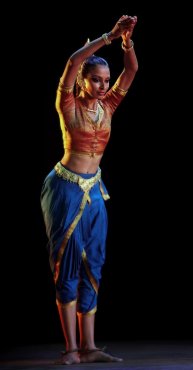 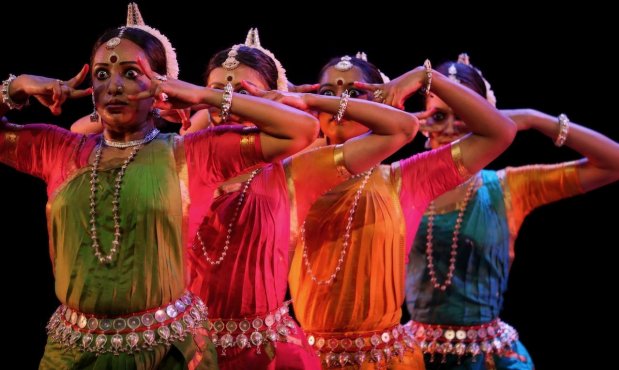 Purna Aarati ‘Purna Aarati’ with temple rituals common to those in India and in Sri Lanka finds felicitous expression in Odissi and Kandyan dancing with configuration of movements that give impression of similarities. After the incredible success of ‘Samhara’ collaborative work both within India and abroad, expectations have been further raised for collaborative choreographic work. The Sri Lankan male dancers Kushal and Akila with their shining dark bodies, wonderful broad bigger than chowka postures, firmly planted feet and extending arms on both sides, with energetic leaps and exquisite virile gait, walk with a spring in their steps, extending arms and moving gracefully, bending to match the dancing apsaras in Odissi, all merging seamlessly to create visuals of unforgettable beauty. Their backs, forming square, sitting, crossing with leaps epitomize energy. The confluence leaves one in wonder for the unity achieved in dancing. Sri Lankan dancers maintaining their own individuality and Odissi dancers theirs, the dancing together creates mood of joy and excitement. 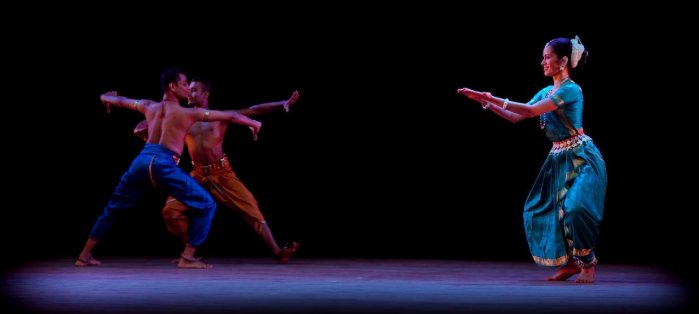 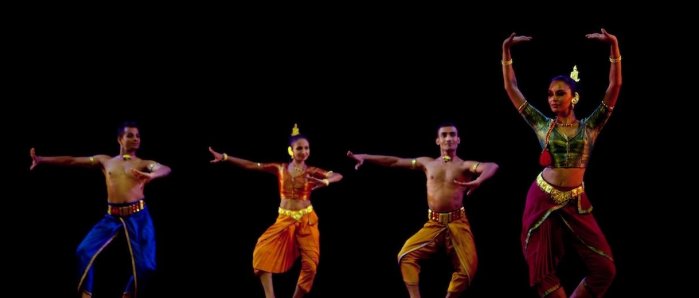 Sri Lankan group The bhramaris (circular movements), utplavanas (leaps) have a special charm with Sri Lankan dancers. As a foil, Odissi dancers' seductive, curvaceous movements, heaving chests, and sculpturesque poses, fill up the stage along with them. There is a continuous movement and none collides. The mnemonic syllables ‘taha kini’ ,’taha kini’, ‘dhak dhak dhinna’ ‘dhaga dha dhina’, with different sound textures enrich the presentation. Raising two arms bending and flying like Garuda, Pavithra slowly gets up and turns into the image of God, and dancers turn into devotees, pulling the chariot, a striking image that one at once recognizes for Rath Yatra. Then the procession starts. They move in circle. For few seconds the lights are switched off and there is darkness except one focused on Lord Jagannath’s idol in one corner and suddenly the sound of cymbals fills up the auditorium. The celebrations of arati become ‘purna,’ complete. The dancers play with stringed cymbals in skillful manner. With that the group dance ends and the audience claps joining in the celebration. The Aalap meets in space and rhythm and embraces the two forms of Odissi and Kandyan dancing unfolding a variety of movements. The kaleidoscopic effect of movements brings forth salient features of Odissi and Kandyan dancing. The Odissi dancers perform on various instruments - veena, mardala, flute and manjira, then three of them hold arms upwards with the mudra suggesting the flower, as it were for offering; the tempo is slow, the Sri Lankan dancers enter from wings and form exquisite formations. Thaji’s solo takes one’s breath away. Here is a vastly gifted dancer with arresting stage presence, and an ability to leap across the stage and land effortlessly planting her feet rock steady on the floor. The male dancers with agility form amazing square, broad stance and with quicksilver leaps take somersaults, aerial movements - no wonder we are amazed. One more arresting movement which captures our attention is when three Odissi dancers move like peacocks in Mayur gati, with one arm lifted up in form of a beak and neck moving gracefully; the Sri Lankan dancers place their arms sideways like feathers of the peacock with body bent and moving forward. 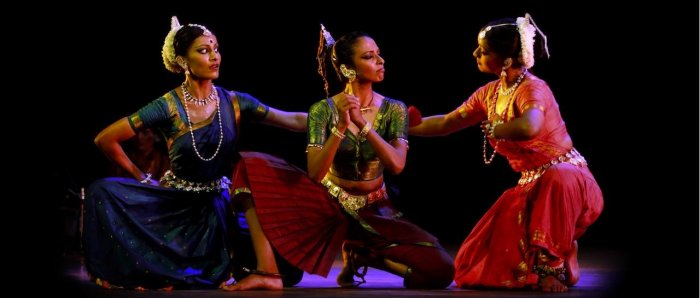 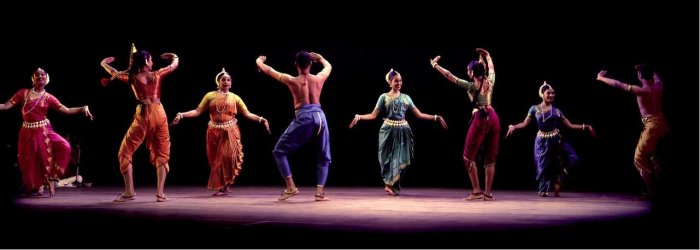 Aalap There is an interesting interlude from Samhara, when Thaji enters from the wing and plays game of dice. The Odissi dancers come and start teasing her. When Thaji places the dice, one of the Odissi dancers picks it up and Thaji tries to snatch it back without success; then the Odissi dancers give back the dice and they dance together with abandon. Suddenly we notice movements used in Moksha. Odissi dancers are joined by Sri Lankan dancers taking leaps and dancing with the Odissi dancers, all moving round the stage. The impact leading to conclusion of the dance reaches a climax and the audience gets up in appreciation of the wonderful confluence of the dance forms. It looked spectacular. Lynne Fernandez with her marvellous understanding of choreography paints the sequences with excellent lighting. She knows where to light up dancers and where to create an overall lighting that leads sequences in seamless manner. Whereas Dhaneswar Swain composed the rhythm for Odissi, Prasanna Rupatilak of Sri Lanka composed for Sri Lankan drum. The musicians were Manu Raj (flute), Jatin Sahoo (vocal), Rohan Dahale (mardala), Surupa Sen (cymbals), and Waruna Sri Hemachandra (Sri Lankan drum). In keeping with the high standards of ‘Samhara’ choreographic work, ‘Ahuti’ has raised the artistic bar of Nrityagram and Chitrasena Dance Company of Sri Lanka.  Dr. Sunil Kothari is a dance historian, scholar, author and critic, Padma Shri awardee and fellow, Sangeet Natak Akademi. Dance Critics' Association, New York, has honoured him with Lifetime Achievement award. Post your comments Please provide your name and email id when you use the Anonymous profile in the blog to post a comment. All appropriate comments posted with name and email id in the blog will also be featured in the site. |